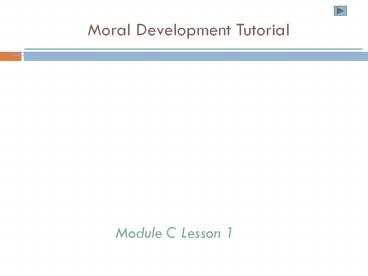Moral Development Tutorial PowerPoint PPT Presentation
Title: Moral Development Tutorial
1
Moral Development Tutorial
Module C Lesson 1
2
How to Navigate Tutorial
- Click on hyperlinks within each slide first.
- Click on to move to the next slide.
- Click on to move to the previous slide.
- Click on the icon to return to the index.
3
Lesson 5 Index
- Theories of Moral Reasoning
- Lawrence Kohlberg
- Carol Gilligan
- John Haidt
- Neurobiological Basis of Moral Reasoning
- In Conclusion
- References
4
Objective 12
- Contrast different theories of moral reasoning,
according to Lawrence Kohlberg, Carol Gilligan,
and John Haidt
5
Lawrence Kohlberg
According to Kohlberg our moral decisions are
motivated by the principles of fairness and
justice
6
Kohlbergs Research
- Kohlberg had male subjects respond moral dilemmas
He wasnt concerned with their resolutions to the
dilemmas, rather how they arrived at those
decisions As a result of his research Kohlberg
concluded that there are qualitative differences
in how moral decisions are made
7
Kohlbergs Theory
- Kohlberg concluded that there are measurable
qualitative patterns of moral thought that he
divided into 3 different levels - Each level is further divided into qualitatively
different stages - As cognitive development progresses we move
through each of these stages - The later stages of development are considered
higher moral thought
8
Pre-Conventional Level
At this level moral decisions are not internally
motivated but are instead driven by external
factors
- Stage 1 Punishment and Obedience
- Moral decisions are made based on avoiding
punishment. - Stage 2 Mutual Benefit
- Moral decisions are made in consideration of
personal interest
9
Conventional Level
At this level moral decisions moral decisions are
not internally motivated but are instead driven
by external factors
- Stage 3 Interpersonal Expectations
- Moral decisions are made based on seeking
approval from others. - Stage 4 Law and Order
- Moral decisions are made consistent with legal
principles and rules
10
Post-Conventional Level
At this level moral decisions moral decisions are
not internally motivated but are instead driven
by external factors
- Stage 5 Legal Principles
- Moral decisions are made based on legal
principles but understanding that laws change and
are not perfect, therefore open to
interpretation. - Stage 6 Universal Moral Principles
- Moral decisions are made based on abstract
principles of justices and fairness, and when in
conflict with the law personal conscious is
followed
11
Evaluating Kohlbergs Theory
- Western emphasis on individual rights, harm, and
justice - It doesnt reflect collectivist emphasis on
interdependence and group harmony - As quoted by a man from New Guinea, If nobody
helped him, I would say that we had caused the
crime. - Only males were studiedso what about women?
12
Carol Gilligan
According to Gilligan womens moral decisions are
driven by a care orientation
13
Carol Gilligan Gender differences
- Gilligan questioned why women were consistently
scoring at the lower levels of moral reasoning
according to Kohlbergs theory - Criticized Kohlbergs theory of moral development
as being biased toward a male perspective (due to
the fact that his research subjects were male) - Gilligan proposed a theory of female moral
development explaining that women are driven by a
care-orientation
14
The Care Orientation
- The moral judgments of women differ from
- that of men in the greater extent to which
- womens judgments are tied to feelings of
- empathy and compassion
- and are concerned with the resolution of real
- as opposed to hypothetical dilemmas.
- Gilligan, 1982
15
Evaluating Gilligans Theory
- Not all women operate from care-orientation
- Culturally shaped gender role for women to be
nurturing
16
John Haidt
According to Haidt we are all driven by 5
universal moral inpulses
17
Harm / Care
18
Fairness / Reciprocity
19
Authority / Respect
20
In-Group Loyalty
21
Purity / Sanctity
22
Evaluating Haidts Theory
- We all share common universal moral impulses but
individually we may have stronger emphasis on one
or more - Liberals more likely to operate from Harm/Care
and Justice/Fairness - Conservatives more likely to operate from
Authority/Respect, In-group Loyalty, and
Purity/Sanctity - Purity/Sanctity is the greatest predictor of
attitudes on abortion and gay marriage
23
Question
- Where does moral thought take place in the brain?
24
The Brain and Moral Reasoning
- Frontal Lobe (blue)
- Temporal Lobe (green)
- Abstract reasoning
- Working memory
- Willful thinking
- Regulates emotions
25
In conclusion
26
What is morality?
- It dependson whose theory you are studying
What do you think?
27
References
Haidt, J. (2007). Moral Psychology and the
Misunderstanding of Religion. Retrieved August
13, 2009 from http//www.edge.org/3rd_culture/haid
t07/haidt07_index.html Jacobs, T. (2009, April
27). Morals Authority. Retrieved October 4,
2009 from http//www.miller-mccune.com/culture_soc
iety/morals-authority-1099/2?article_page3. Kim,
E. (n.d.). Moral Reasoning Lawrence Kohlberg.
Retrieved from https//teach.lanecc.edu/kime/Nov25
A02Psy201.pdf. Naukan, D. and Fredendall, C.
(n.d.). Morality in Kohlberg and Gilligan
PowerPoint. Retrieved October 4, 2009 from
http//dante.udallas.edu/fredendall/child_growth/C
hildGrowth/Kohlberg.ppt. Newberg, A. and
Waldman, M.R. (2006). Why We Believe What We
Believe Uncovering Our Biological Need for
Meaning, Spirituality, and Truth. New York Free
Press.

